The spiderwort not only embellishes pond banks and beds, but is also a real eye-catcher in every apartment and every bed with its magnificent leaf decoration and the bright flowers.
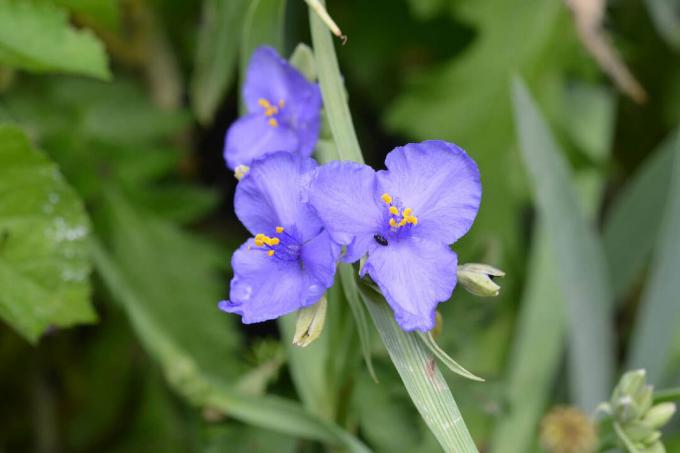
Spiderwort (Tradescantia) is characterized above all by its exotic appearance and at the same time its ease of care. In this article you will learn which species are suitable for the house or garden and which small steps you can take to properly care for the spiderwort.
contents
- Spiderwort: flower, origin and properties
-
The most beautiful Tradescantia species
- Spiderworts as indoor plants
- Hardy spiderworts
-
Plant spiderwort: location, time and procedure
- Spiderwort as a houseplant
- Plant spiderwort in the garden
-
Care of the Tradescantia
- Maintain spiderworts in the room
- Caring for spiderworts in the garden
- Is Tradescantia hardy?
- Multiply spiderworts
- Is the spiderwort poisonous?
Spiderwort: flower, origin and properties
The spiderwort, which originated in South and Central America, made its way into the world in the mid-17th century. Century with the seafaring to Europe. It is also known as God's Eye or Wild Heinrich and belongs to the Commelinaceae (Commelinaceae). It is a genus of plants that includes about 65 different species. So spiderworts can grow in the garden as perennial, lush perennials. Other species are popular as houseplants in traffic light pots because of their drooping shoots. The leaves are sessile, tapering and, depending on the variety, lanceolate or pointed-ovate. The leaf color varies from light to dark green depending on the variety. Some varieties have a particularly decorative red underside of the leaves, which is why these varieties of Spiderwort are only grown because of the beautiful foliage. There are also species and varieties of spiderwort with multicolored leaves, such as zebra herb. The flowers of
Tradescantia-Species are mostly blue, violet, white or pink-red. The flowering period varies from May to September, depending on the variety. The single, small flower only blooms for a few days, but this is not noticeable due to the large number of flowers and the rapid rushing of buds and flowers. If the spiderwort grows outdoors, the small flowers also offer bees a rich supply of pollen and nectar.
The most beautiful Tradescantia species
The genus of spiderworts is extremely diverse. The different looking ones Tradescantia-Species range from small-leaved houseplants to reed-like perennials that like to grow at the water's edge. We briefly present the most beautiful types here.
Spiderworts as indoor plants
Mexican Spiderwort (Tradescantia pallida): The Mexican spiderwort is native to Mexico and is characterized by striking stem and leaf color. The reddish to violet coloring of the Mexican spiderwort also gives it the name red leaf. In order not to lose the impressive leaf color, the Mexican spiderwort needs a full sun as a houseplant.
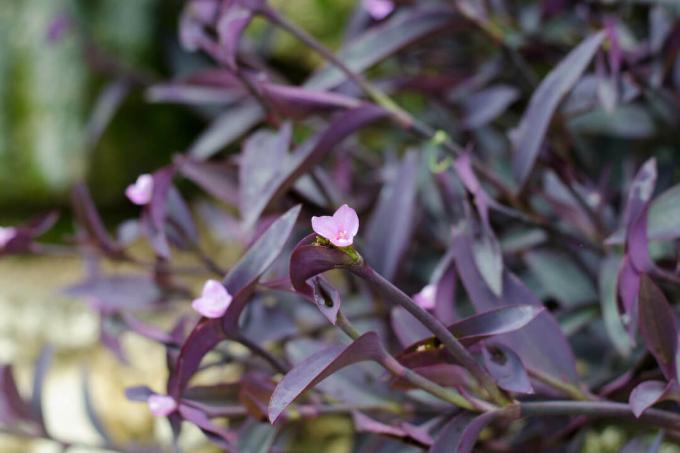
White-blooded God's Eye (Tradescantia fluminensis): The white-flowered god's eye, also called Rio spiderwort, comes from the tropical parts of South America and grows stocky with hanging shoots. Leaves and stems are glossy and striped in solid green to green-white. Flowering is rare in this species. However, it is excellent as a decorative traffic light plant indoors.
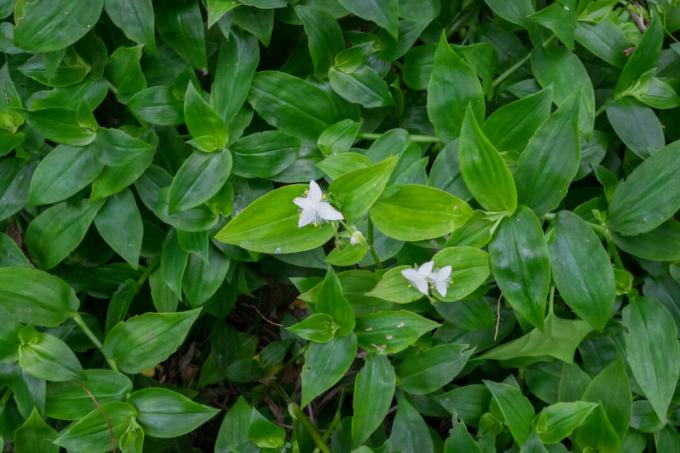
zebra weed (Tradescantia zebrina): Named for its striking appearance zebra weed comes from Mexico and Colombia. The leaves are green and silver-grey, occasionally streaked with pink. The zebra herb is ideal as a houseplant in a bright but not full sun location.
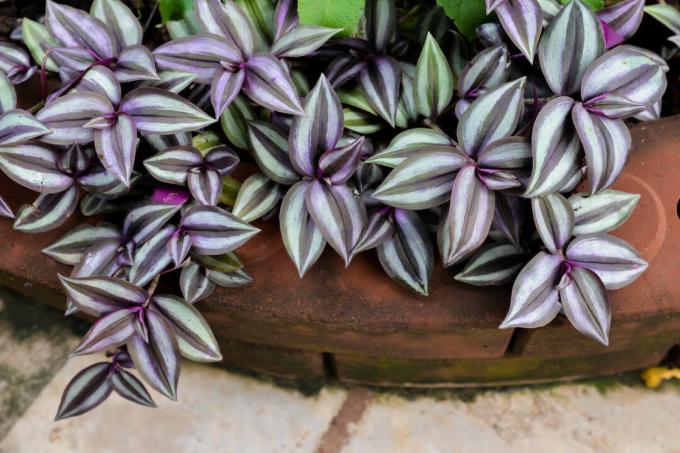
Purple-leaved Spiderwort (Tradescantia spathacea): The purple-leaved spiderwort is an evergreen rosette-growing variety Tradescantiaspecies that is very popular because of its striking bracts. The leaves are green to green-white striped on top and red on the underside. It is often confused with the dragon tree because of this coloration.

Hardy spiderworts
The hardy spiderworts can also deal with low temperatures and are therefore also suitable for planting in the garden.
Virginia spiderwort (Tradescantia virginia): The Virginia spiderwort is a common ornamental plant in parks and gardens. It also comes from South and Central America and is one of the frost-tolerant and therefore hardy Tradescantia-Species. The leaves and stems are long and narrow, resembling reed leaves. Virginia spiderwort can spread through the rootstock over time.
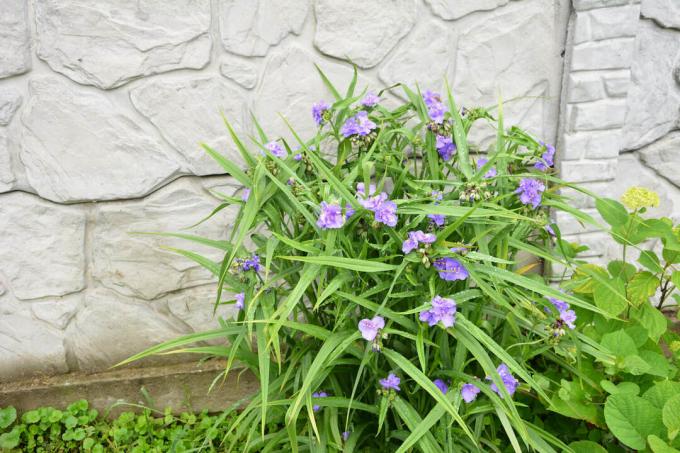
Garden Spiderwort (Tradescantia x andersoniana): The garden tradeskantie is also frost hardy and can be planted in the garden. There are different varieties that differ in the color of the flowers. The 'Bilberry Ice' variety, for example, is particularly pretty with its petals colored white and soft purple. The 'Sweet Kate' variety, on the other hand, flowers in a very dark purple.
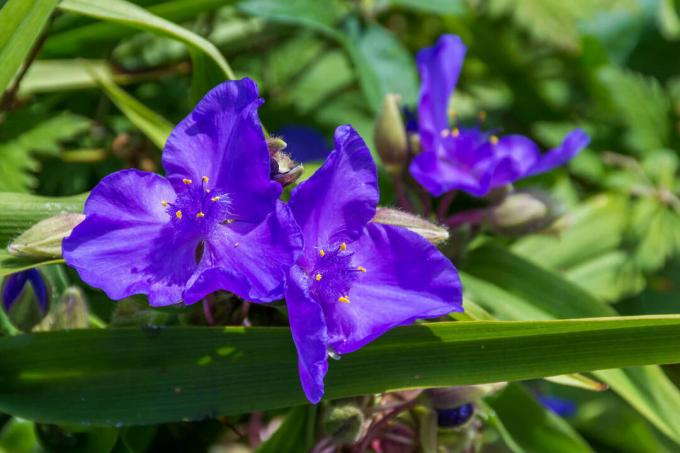
Ohio Spiderwort (Tradescantia ohiensis): As a prairie wild species, the Ohio spiderwort can handle drought even better than the related garden spiderwort. The flowers shine in a bright blue-violet.
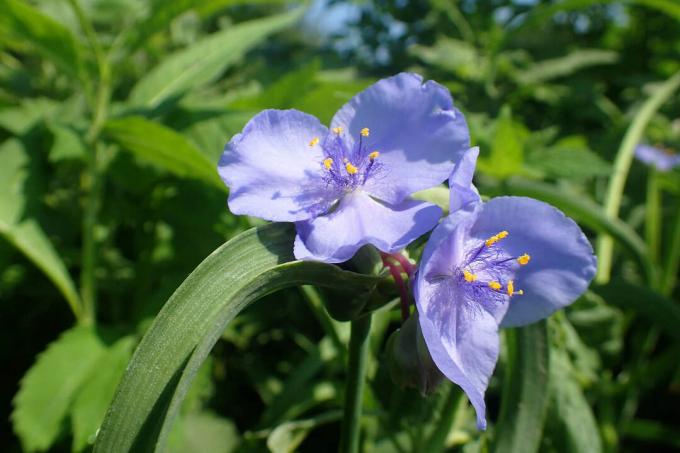
Plant spiderwort: location, time and procedure
The easy-care spiderwort generally does not make any great demands on its location. If the location is chosen appropriately from the beginning, depending on the species, the spiderwort grows without much care. Lots Tradescantia- Varieties and species are not frost tolerant and are therefore only kept as house plants. The hardy species can be planted outside in beds or at the edges of ponds as exotic eye-catchers.

Spiderwort as a houseplant
The foliage of the spiderwort makes it a visual highlight as a houseplant. If you keep the Spiderwort hanging in a traffic light pot, you can perfectly showcase its long shoots. The temperature should correspond to the normal room temperature of 20 to 25 °C. Place the spiderwort in a light but not sunny spot. In summer, the spiderworts can also be kept on the balcony or terrace. Here it is also important to pay attention to a location that does not expose the plant to full sun. In winter, spiderworts like to be cooler, but never below 10 °C.
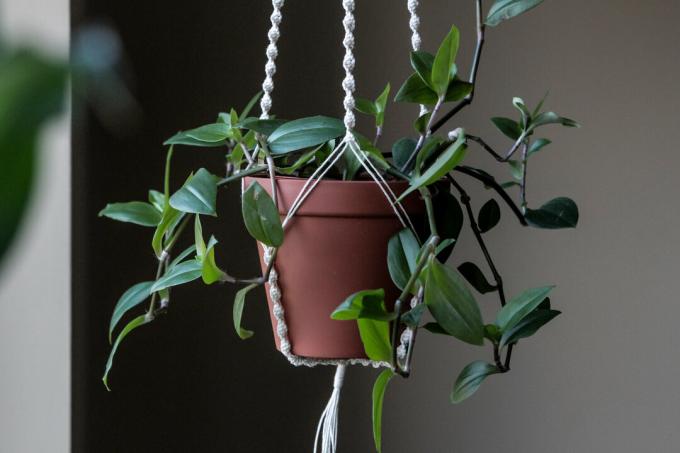
As a houseplant or potted plant on the balcony, the spiderwort needs a substrate with selected organic and mineral components. A substrate made of compost-based potting soil, to which sand and coarse pieces of bark are added, is ideal. This ensures adequate ventilation. Our Plantura organic compost Due to the high humus content, it is ideal for supplying the plants with sufficient nutrients. A drainage layer on the bottom of the pot, for example made of expanded clay or potsherds, helps to avoid waterlogging.
tip: The patterned or reddish varieties require more light than the solid green varieties.
Plant spiderwort in the garden
Spiderwort can be used as a lush perennial in gardens, parks and flower beds, as well as for planting around ponds and streams. Only varieties with sufficient frost hardiness are suitable for planting in the garden.
Spiderworts for the garden are adaptable perennials for almost any light condition. However, locations in full sun and full shade should be avoided. In the garden as well as in pots, spiderworts prefer a location on humus-rich and nutrient-rich soil. The soil should be able to store enough water, but not be prone to waterlogging. Since they like fresh, moist soil, hardy spiderworts also feel at home on the banks of a garden pond.

Young spiderworts should be planted in the garden from mid-May so that late frosts do not weaken the small plants. Alternatively, planting in autumn is also possible. Those who prefer to grow the three-masted plants themselves from seed should start in mid-March before they can be planted out eight weeks later. The three master plant prefers a single planting with a distance of 20 to 30 cm. Since most species tend to grow quickly and bushy, gaps in the bed close quickly. If the plant overgrows the bed, it is advisable to cut it off regularly.
Tip: Spiderwort is a plant spurned by snails.
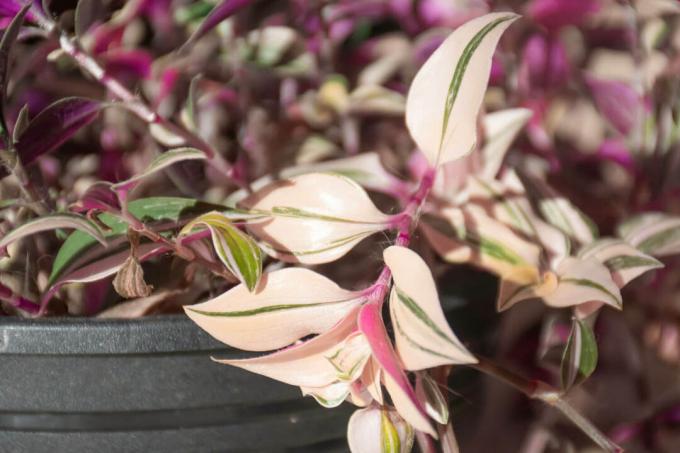
Care of the Tradescantia
the Tradescantia-Maintenance is not particularly complex, since the main thing is to ensure that there is enough water. If a little fertilizer is added, the spiderwort feels completely at ease.
Maintain spiderworts in the room
Spiderworts that grow as houseplants do not need pruning. However, if the plant grows too large, it can be trimmed at any time. It is important to ensure that no more than a third of the shoot length is shortened. Old buds could be removed periodically to encourage bud replenishment. However, it is important not to remove the flowering site itself, as this is where the new flowers will sprout again.
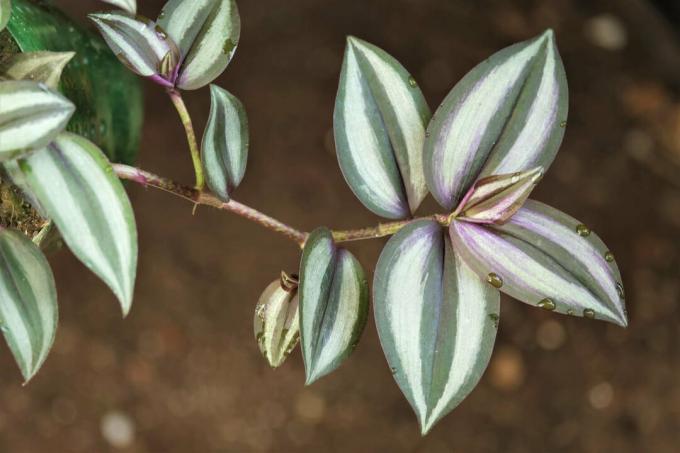
Indoor spiderworts should be supplied with a suitable fertilizer about once a month during the growth phase from April to August. In order to optimally supply roots and leaves with nutrients, our Plantura organic indoor and green plant fertilizer be added at regular intervals via the irrigation water. Our primarily organic fertilizer contains the nutrients nitrogen and potassium in the ideal ratio for ornamental foliage plants such as Tradescantia zebrina.
The soil should be kept evenly moist. As soon as the substrate dries on the surface, it is poured with lime-free water. Excess water in the coaster should be removed after about 15 minutes.
Caring for spiderworts in the garden
Tradescantia-Species that grow in the garden, however, should be pruned back annually. The best time for this is autumn, when all the flowers and leaves have withered. When all the leaves have dried up, the spiderwort can be shortened to a height of 10 cm. Even with outdoor plants, removing old blooms can encourage a longer flowering period.
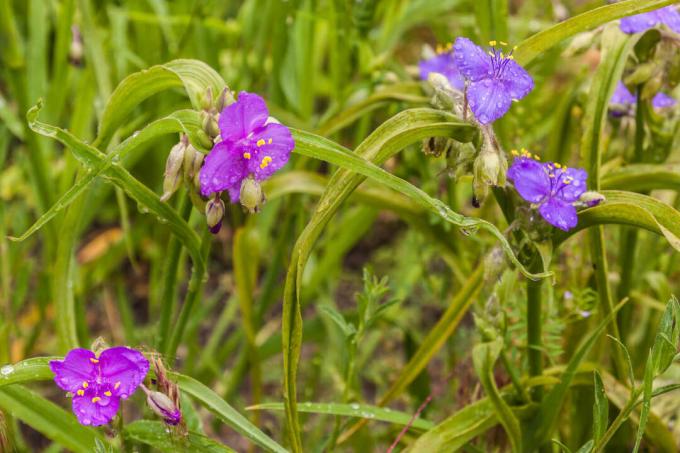
Fertilizing the three-master plant is only rarely necessary when using optimal soil substrate. In the garden, compost or compost soil should be added regularly in the spring.
The watering of the spiderwort should be done at regular intervals to allow the plant to absorb enough water. It also depends on the location and the weather. Spiderworts that stand on the edge of a pond need to be watered less often than those on drier soil. Water about two to three times a week and finger test the soil before watering.
Is Tradescantia hardy?
Certain hardy species of spiderwort can also be planted in beds or tubs in the garden all year round. These include, for example, the garden spiderwort (Tradescantia xandersoniana), the Ohio Spiderwort (Tradescantia ohiensis) or the Virginia spiderwort (Tradescantia virginia). No protective measures are necessary to overwinter these spiderworts, as the frost-hardy species tolerate temperatures of down to -20 °C.
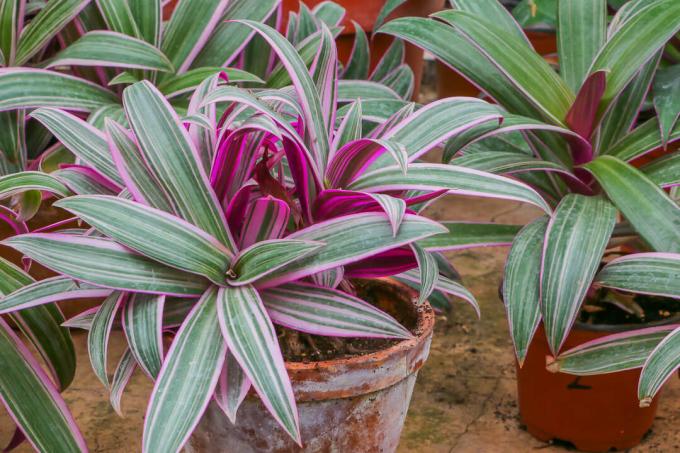
The non-hardy indoor spiderworts, such as the purple-leaved spiderwort (Tradescantia discolor) or the white-blooded god's eye (Tradescantia fluminensis) can be overwintered at warm room temperatures or slightly cooler at at least 10 °C. Both indoor and outdoor plants should stop fertilizing from autumn. Watering of indoor plants should also be reduced in winter to prevent waterlogging and rot.
Multiply spiderworts
The easiest method of propagation of Tradescantia-Species in the division of older perennials. However, cuttings or seeds can also be used to propagate the spiderworts.
Dividing a spiderwort is best done in spring or autumn. In general, it is advisable to divide large plants in pots every three years, otherwise the pot will quickly become too small. The plant can be roughly divided with a spade. Then dead roots or plant parts should be removed and both plants should be planted again in a suitable substrate and watered generously. With this method of propagation you get plants of the same variety and therefore with the same characteristics.
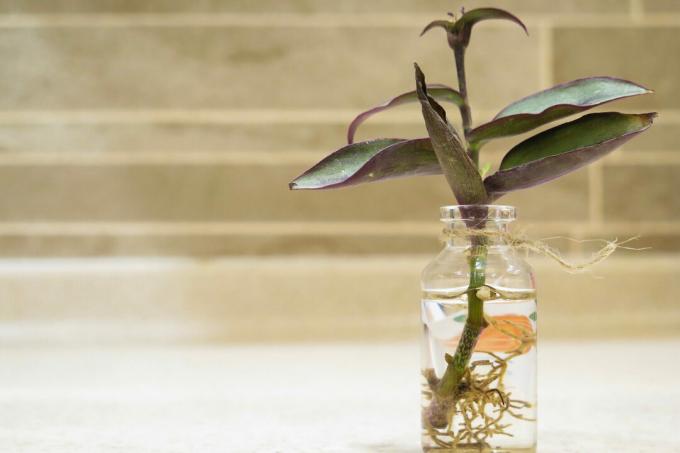
If you want to grow several plants at once, you can propagate with cuttings all year round. To do this, strong shoots of about 10 cm in length are cut off and the lower leaves are removed. The cuttings can either be placed in a glass of water or directly in the ground. Depending on the pot size, there is room for up to 8 cuttings next to each other. Compost or universal soil is suitable for the young plants, with a third of sand mixed in. In a bright and warm location at 16 to 18 °C, roots are formed quickly. When the first new leaves appear, the plants are isolated and cared for like older plants.
It can also be propagated from ripe seeds. Outdoor plants often multiply by self-seeding in the bed. Plants from seeds should be preferred on the windowsill from mid-March. A temperature of around 20°C is ideal for germination. The germination time is usually 10 to 20 days. Depending on the species, the plants can then be repotted as indoor or outdoor plants.
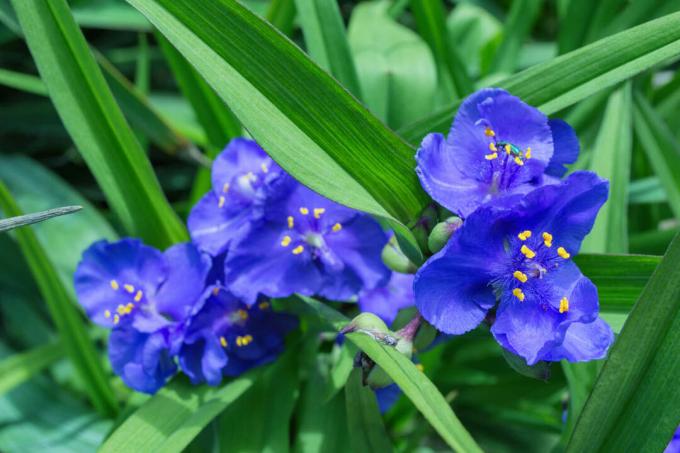
Is the spiderwort poisonous?
The species of spiderwort are poisonous, but only to a very small extent. They are therefore considered harmless.
tip: Indoors, it is advisable to hang the spiderwort as a traffic light so that children or pets do not inadvertently eat parts of the plant.
Spiderworts are also ideal for bank planting. We put 20 pond plants in front, from the shore to the deep water zone.


